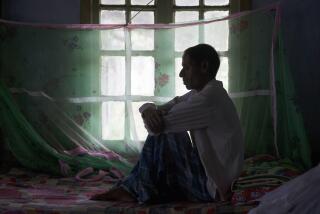Trouble in Paradise : Bucolic Sonoma County Jolted by Scope of AIDS
- Share via
SANTA ROSA, Calif. — County hospital workers first glimpsed the grim future last December. In one terrible week, they recall, seven men died of AIDS--and eight others were condemned with the same fatal diagnosis.
“That was the first realization that things were getting worse instead of better,” said Steven Parker, a former emergency medical technician who runs rural Sonoma County’s AIDS awareness program.
It also was the first realization for many people here and elsewhere that AIDS, the deadly acquired immune deficiency syndrome, was fulfilling medical predictions that the disease would spread from city to suburb. In fact, there are nearly the same number of cases per 100,000 population in Sonoma County as there are in Los Angeles County.
Sonoma County has the state’s third-highest per-capita rate of AIDS patients--31.2 per 100,000 residents. San Francisco leads the state with 358.2 cases per 100,000; Los Angeles County is second with 31.8.
“The sad part is that the predictions of two years ago really came true,” said Marsha Lowe, an infection control nurse at one of Sonoma County’s largest hospitals.
“What worries me,” added Marylin Batt, a microbiologist at the same facility, “is whether the predictions of today are going to come true, too. Are a thousand people going to die of this disease in this one small county--and hundreds of thousands all over the world?”
Just that question led the Sonoma County Board of Supervisors last month to declare a medical state of emergency. The board was attempting to qualify for more state funds to prepare county hospitals for the swelling ranks of gravely ill AIDS patients expected by the end of the decade.
That such a move should be taken in Sonoma County, which is better known as a bucolic home for wine grapes and dairy herds, underlines the concerns of the state’s top health officials.
As of the end of February, figures from the state Department of Health Services showed that 7,490 Californians had been diagnosed as having AIDS and 4,086 had died. The AIDS virus attacks the body’s immune system, leaving the victim vulnerable to a variety of infections and tumors. It is transmitted by sexual contact, by contaminated needles and blood and from infected mothers to newborn infants.
Although a large majority of cases still are diagnosed in San Francisco and Los Angeles counties, AIDS also has started to show up more often in counties outside of the big-city orbit--in Mendocino and San Luis Obispo, Imperial and Placer.
More than 150 cases had been reported in rural counties not usually linked with the two high-risk groups most often associated with AIDS--homosexual men and intravenous drug users. More than 80 people have died in these areas and more may still. Butte County, for example, has only four AIDS patients now, but limited testing has shown that 10 times that many people have been exposed to the AIDS virus and may eventually develop the disease, according to the state Department of Health Services.
State figures show that 86 AIDS cases have been diagnosed in Sonoma County alone, resulting in 44 deaths. However, Sonoma officials say that through the end of 1986, they actually had treated 103 AIDS patients and recorded 63 AIDS-related deaths. The difference apparently is the result of immigration of AIDS patients to the county.
In addition, county officials estimate that 3,000 to 12,000 of the county’s 330,000 residents have been exposed to the AIDS virus; more exact figures have not been compiled from test results. However, by 1990, the county predicts the number of cases will reach 1,850 and the number of deaths will hit 1,000.
Parker warned supervisors that the county soon will need a dedicated AIDS hospital ward to care for the sick--and AIDS hospices for the dying.
“If you look at it on a per-capita basis, that is very high,” said Dr. Marshall Kubota, who serves the small western Sonoma County hamlet of Guerneville and estimates that half of the time in his practice is devoted to his 30 AIDS patients.
Kubota, who came to Guerneville through the U.S. Public Health Service to make up for a lack of physicians in the area, has become the county’s leading expert on the disease. He now is being actively courted by the county to stay and train other doctors in the difficult task of diagnosing and treating AIDS.
Although Guerneville and other Russian River resorts attract gay customers, Kubota said that only about a third of the county’s AIDS patients live along the river. A larger group, about half of the county’s AIDS cases, can be found in Santa Rosa, an affluent, middle-class, family-oriented city of 95,300.
“Part of it is (attributable to) the river area,” the doctor said of the county’s high incidence of AIDS, “but most of it is just due to the natural progression of the disease.”
The county made its emergency declaration to qualify for a Special Needs and Priorities (SNAP) grant, money that is provided to counties confronting unexpected health-related problems. Ed Mendoza of the Department of Health Services, which administers the fund, said Sonoma’s request for $20,000 is the first SNAP grant application made for AIDS-related matters. The request, he said, still is being considered.
But the emergency declaration already has focused public attention on the problem--and scared more than a few formerly complacent residents into making an appointment for one of the free, anonymous AIDS screening tests offered by the county.
“The calls--oh! The calls have just been incredible,” said Lowe, adding that a growing number are coming from single women seeking advice on the best ways to avoid contracting the disease.
“Overnight, it went from one extreme to the other,” said Parker, who runs the small cadre of volunteers staffing the AIDS hot line in a cramped corner of the county’s Public Health Department building. “It went from people saying, ‘Who cares?’ to ‘Oh, my gosh!’
“I had one lady call and say she had been married seven years and that six years ago she had an affair with a traveling salesman. . . . I told her that she probably shouldn’t worry, but I’m not sure that helped. Some people are scared to death.”
Education programs have been increased and money is being sought for further expansion, Parker said, because the only way known to fight the disease is to check its spread. Most vigorously emphasized here, as elsewhere, are “safe sex” techniques, especially the use of condoms.
Money is a major worry, Parker and others added, because Sonoma County’s budget is relatively small, the cost of caring for AIDS patients is high and, unlike the state’s big cities, there is little local charitable fund-raising talent.
“Counseling, testing, caring, and everything--the county is trying to do all of this with nothing. Zero,” Batt said.
She and others hope that the surge of public concern that has followed the county’s medical-emergency declaration will translate into public support.
“The supervisors’ action has drawn everyone closer together,” Lowe said. “Before February, the general populace felt, ‘Yeah, it’s out there. So what?’ But now they know it can happen to them . . . and we have to do something about it.”
Times researcher Norma Kaufman in San Francisco contributed to this article.
More to Read
Sign up for Essential California
The most important California stories and recommendations in your inbox every morning.
You may occasionally receive promotional content from the Los Angeles Times.













